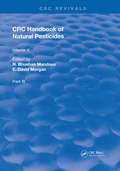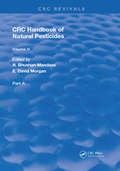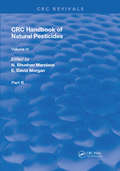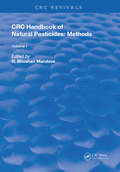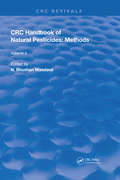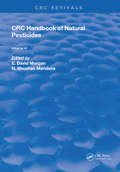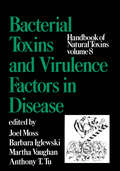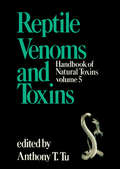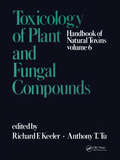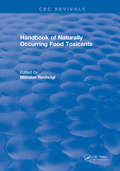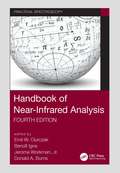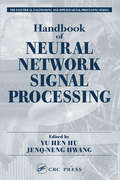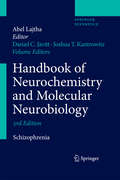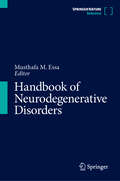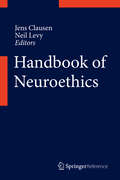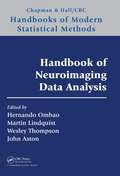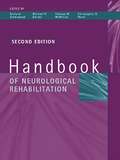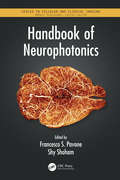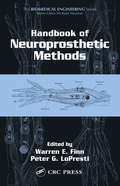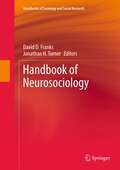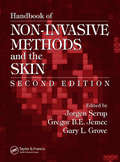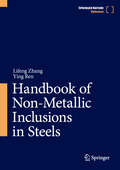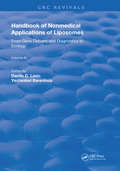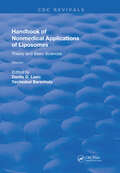- Table View
- List View
Handbook of Natural Pesticides: Part B, Volume III
by N. Bhushan MandavaThis handbook series includes several naturally occurring chemicals that exhibit biological activity. These chemicals are derived from plants, insects, and several microorganisms. Volume I of this series is covers the theory and practice of the strategies for pest control and methods for detection.Moreover, it presents extensive tables that provide the information you need to select the most appropriate bioassay for a particular plant growth regulator or hormone. In addition to the chapters on bioassays, Volume I provides a solid introduction to the theory and practice of natural pesticide use, including in-depth discussions of integrated management systems for weed and pest control, the state-of-the-art use of computers in pest management, and allelochemicals as natural protection. Guidelines on toxicological testing and EPA regulation of natural pesticides are also detailed.
Handbook of Natural Pesticides: Pheromono, Part A, Volume IV
by N. Bhushan MandavaThis handbook series includes several naturally occurring chemicals that exhibit biological activity. These chemicals are derived from plants, insects, and several microorganisms. Volume I of this series is covers the theory and practice of the strategies for pest control and methods for detection.Moreover, it presents extensive tables that provide the information you need to select the most appropriate bioassay for a particular plant growth regulator or hormone. In addition to the chapters on bioassays, Volume I provides a solid introduction to the theory and practice of natural pesticide use, including in-depth discussions of integrated management systems for weed and pest control, the state-of-the-art use of computers in pest management, and allelochemicals as natural protection. Guidelines on toxicological testing and EPA regulation of natural pesticides are also detailed.
Handbook of Natural Pesticides: Pheromono, Part B, Volume IV
by N. Bhushan MandavaThis handbook series includes several naturally occurring chemicals that exhibit biological activity. These chemicals are derived from plants, insects, and several microorganisms. Volume I of this series is covers the theory and practice of the strategies for pest control and methods for detection.Moreover, it presents extensive tables that provide the information you need to select the most appropriate bioassay for a particular plant growth regulator or hormone. In addition to the chapters on bioassays, Volume I provides a solid introduction to the theory and practice of natural pesticide use, including in-depth discussions of integrated management systems for weed and pest control, the state-of-the-art use of computers in pest management, and allelochemicals as natural protection. Guidelines on toxicological testing and EPA regulation of natural pesticides are also detailed.
Handbook of Natural Pesticides: Volume I: Theory, Practice, and Detection (Crc Series In Naturally Occurring Pesticides)
by N. Bhushan MandavaThis handbook series includes several naturally occurring chemicals that exhibit biological activity. These chemicals are derived from plants, insects, and several microorganisms. Volume I of this series is covers the theory and practice of the strategies for pest control and methods for detection.Moreover, it presents extensive tables that provide the information you need to select the most appropriate bioassay for a particular plant growth regulator or hormone. In addition to the chapters on bioassays, Volume I provides a solid introduction to the theory and practice of natural pesticide use, including in-depth discussions of integrated management systems for weed and pest control, the state-of-the-art use of computers in pest management, and allelochemicals as natural protection. Guidelines on toxicological testing and EPA regulation of natural pesticides are also detailed.
Handbook of Natural Pesticides: Volume II: Isolation and Identification (Crc Series In Naturally Occurring Pesticides)
by N. Bhushan MandavaThis handbook series includes several naturally occurring chemicals that exhibit biological activity. These chemicals are derived from plants, insects, and several microorganisms. Volume II of this series is devoted to methods for isolation and identification for pest control technology.Methods for isolation and characterization are very important for gaining knowledge on how to discover these chemicals when present in such minute amounts (ppm to ppb levels) in nature. Several chemical and biological methods have been developed for isolation, characterization, and analysis of natural pesticides and are included in Volume II.
Handbook of Natural Pesticides: Volume VI: Insect Attractants and Repellents (Crc Series In Naturally Occurring Pesticides)
by E. David MorganThis volume addresses chemical interactions between insects and plants, such as feeding and ovipositional attractants and deterrents. It begins with a general introduction to insects in a chemical world. Included is a discussion of molecular biology and genetics in insect control, with respect to potentially inserting the genes for the synthesis of a protective substance into a crop plant. Also covered is the detoxification of plant substances by insects. This volume is especially helpful for chemists and biologists in the field of pesticide research.
Handbook of Natural Toxins, Volume 8: Bacterial Toxins and Virulence Factors in Disease
by Joel MossThis volume describes the structure and function of bacterial toxins and presents a comprehensive review of virulence factors, providing recent information concerning cell physiology and biochemistry, as well as new toxin tools for experimental studies and clinical therapy. A wide variety of toxic proteins, including the toxins that cause diptheria
Handbook of Natural Toxins: Reptile Venoms and Toxins (Handbook Of Natural Toxins Ser.)
by Anthony T. TuIn 24 contributed chapters, 37 international specialists describe the latest developments in research on snake venom including different types of venoms and toxins, actions, antidotes, and applications and summarize what is known to date on Gila monster and frog toxins. Some 70 tables provide essent
Handbook of Natural Toxins: Toxicology of Plant and Fungal Compounds
by R. F. KeelerFeaturing the work of 55 leading authorities on natural toxins, this new volume highlights the diversity of chemical classes among toxins, the range of effects on biological systems, and the variety of expressions of toxicoses.Supplying findings that have yielded significant solutions to practical toxicoses problems, this exceptional reference describes the toxicology and chemistry of toxic and phar macologically active compounds from plants and fungi ... discusses the occurrence, incidence, and epidemiology of several types of plant and fungal compound-induced toxicoses in man and animals ... details the structure/activity relation of several plant and fungal toxins and plant teratogens ... covers the toxicologic effects of many plant and fungal compounds on the lung, liver, heart, gastrointestinal tract, muscle, skin, and other organs ... considers the potential usefulness of plant and fungal substances as herbicides, pesticides, and insecticides ... examines plant/herbivore, plant/plant, and plant/fungal interactions as related to plant and fungal toxins ... presents current techniques used in toxicology and teratology studies ... and more!Toxicology of Plant and Fungal Compounds is an indispensable reference for toxicologists; biologists; natural product and organic chemists and biochemists; veterinarians; plant pathologists; land managers; health department personnel; and graduate school students in toxicology, biology, pharmacology, and public health.
Handbook of Naturally Occurring Food Toxicants (Crc Series In Nutrition And Food)
by Miloslav RechciglIn the last decade an increased concern has been voiced against various environmental hazards, particularly chemicals that may cause harm to humans or animals. Numerous studies which have dealt with this subject invariably have focused on chemical contaminants of some component of a food chain. In contrast, much less attention has been paid to the potentially harmful substances that may occur in foodstuffs naturally. The purpose of this Handbook is to sensitize the reader to this problem and to provide a systematic overview of the most important naturally occurring food toxicants. The Handbook should be of interest to anybody who is concerned with nutritive and health aspects of food. Inasmuch as many of the discussed toxicants can be removed or destroyed by a suitable method of food rpocessing it should be of special value to food technologists.
Handbook of Near-Infrared Analysis (Practical Spectroscopy)
by Emil W. Ciurczak Benoît Igne Jerome Workman Jr. Donald A. BurnsRapid, inexpensive, and easy-to-deploy, near-infrared (NIR) spectroscopy can be used to analyze samples of virtually any composition, origin, and condition. The Handbook of Near Infrared Analysis, Fourth Edition, explores the factors necessary to perform accurate and time- and cost-effective analyses across a growing spectrum of disciplines. This updated and expanded edition incorporates the latest advances in instrumentation, computerization, chemometrics applied to NIR spectroscopy, and method development in NIR spectroscopy, and underscores current trends in sample preparation, calibration transfer, process control, data analysis, instrument performance testing, and commercial NIR instrumentation. This work offers readers an unparalleled combination of theoretical foundations, cutting-edge applications, and practical experience. Additional features include the following: Explains how to perform accurate as well as time- and cost-effective analyses. Reviews software-enabled chemometric methods and other trends in data analysis. Highlights novel applications in pharmaceuticals, polymers, plastics, petrochemicals, textiles, foods and beverages, baked products, agricultural products, biomedicine, nutraceuticals, and counterfeit detection. Underscores current trends in sample preparation, calibration transfer, process control, data analysis, and multiple aspects of commercial NIR instrumentation. Offering the most complete single-source guide of its kind, the Handbook of Near Infrared Analysis, Fourth Edition, continues to offer practicing chemists and spectroscopists an unparalleled combination of theoretical foundations, cutting-edge applications, and detailed practical experience provided firsthand by more than 50 experts in the field.
Handbook of Neural Network Signal Processing (Electrical Engineering & Applied Signal Processing Series)
by YU HEN HU AND JENQ-NENG HWANGThe use of neural networks is permeating every area of signal processing. They can provide powerful means for solving many problems, especially in nonlinear, real-time, adaptive, and blind signal processing. The Handbook of Neural Network Signal Processing brings together applications that were previously scattered among various publications to provide an up-to-date, detailed treatment of the subject from an engineering point of view.The authors cover basic principles, modeling, algorithms, architectures, implementation procedures, and well-designed simulation examples of audio, video, speech, communication, geophysical, sonar, radar, medical, and many other signals. The subject of neural networks and their application to signal processing is constantly improving. You need a handy reference that will inform you of current applications in this new area. The Handbook of Neural Network Signal Processing provides this much needed service for all engineers and scientists in the field.
Handbook of Neurochemistry and Molecular Neurobiology
by Abel Lajtha Joshua Kantrowitz Daniel C. JavittThis volume of the Handbook of Neurochemistry and Molecular Neurobiology focuses on neurochemical aspects of schizophrenia. Chapters cover the full range of schizophrenia symptoms and anatomical pathologies from neurochemical and molecular biology perspectives. Topics include changes in neurotransmitter systems, alteration in receptors, neurotransmitter release, genetic factors, protein alterations, and redox dysregulation.
Handbook of Neurodegenerative Disorders
by Musthafa M. EssaThis Handbook discusses the pathology, etiology, pathogenesis, and therapeutic interventions of different neurodegenerative diseases. The initial section of the Handbook reviews the recent advances in understanding neurodegenerative diseases and the commonalities and differences between the major pathologies. The subsequent section presents recent developments in understanding fundamental biological mechanisms that influence the onset and development of neurodegenerative diseases. It provides current biomedical studies that are aimed at identifying the underlying causes of neurodegeneration. The book also examines the recent observations from biological, cellular, and studies from the model organisms for gaining mechanistic insights into neurodegenerative disorders. It also presents the epidemiological and genetics studies relevant to clinical aspects of neurodegenerative diseases. The book's subsequent chapters offer new and more effective therapeutic strategies to combat these devastating diseases. Towards the end, the Handbook presents recent advances in molecular diagnostics for neurodegenerative disorders and a perspective on the future directions to provide a framework for further developments and refinements of molecular diagnostics to combat neurodegenerative diseases.
Handbook of Neuroethics
by Neil Levy Jens ClausenBased on the study of neuroscientific developments and innovations, examined from different angles, this Handbook provides a comprehensive overview of the international neuroethical debate, and offers unprecedented insights into the impact of neuroscientific research, diagnosis, and therapy. Neuroethics as a multi-disciplinary and inter-disciplinary endeavor examines the implications of the neurosciences for human beings in general and for their self-understanding and their social interactions in particular. The range of approaches adopted in neuroethics and thus in this handbook includes but is not limited to historical, anthropological, ethical, philosophical, theological, sociological and legal approaches. The Handbook deals with a plethora of topics, divided into in three parts: the first part contains discussions of theories of neuroethics and how neuroscience impacts on our understanding of personal identity, free will, and other philosophical concepts. The second part is dedicated to issues involved in current and future clinical applications of neurosciences, such as brain stimulation, brain imaging, prosthetics, addiction, and psychiatric ethics. The final part deals with neuroethics and society and includes chapters on neurolaw, neurotheology, neuromarketing, and enhancement. "
Handbook of Neuroimaging Data Analysis (Chapman & Hall/CRC Handbooks of Modern Statistical Methods)
by John Aston Hernando Ombao Martin Lindquist Wesley ThompsonThis book explores various state-of-the-art aspects behind the statistical analysis of neuroimaging data. It examines the development of novel statistical approaches to model brain data. Designed for researchers in statistics, biostatistics, computer science, cognitive science, computer engineering, biomedical engineering, applied mathematics, physics, and radiology, the book can also be used as a textbook for graduate-level courses in statistics and biostatistics or as a self-study reference for Ph.D. students in statistics, biostatistics, psychology, neuroscience, and computer science.
Handbook of Neurological Rehabilitation
by Christopher D. Ward Richard J. Greenwood Michael P. Barnes Thomas M. McMillanChanges in the focus of neurological practice worldwide have led to the need for new standard texts that reflect the current state of this expanding area of clinical expertise. The second edition of the Handbook of Neurological Rehabilitation is a major reference source that fulfils this need, providing an invaluable resource for all professions that work with patients suffering from neurological disorders. It brings restorative neurology to the bedside and shows how a reiterative, goal-oriented, problem-solving training programme can benefit patients, sometimes on a scale not achieved by pharmacological or surgical interventions.The book is divided into three sections all of which have been updated. Section One explores the clinical and biological principles underpinning rehabilitation practice in the context of neurological disablement. Section Two describes the assessment, treatment, and management of the major physical, cognitive and behavioural impairments, and the resulting functional deficits that may follow or accompany neurological disease. The final section explores in more detail these problems and their management in relation to the more common specific disorders of the nervous system.The text emphasises the fact that rehabilitation is an ongoing process involving multidisciplinary problem-solving, goal-setting and education; in which organised care is more effective than unorganised care; and the breakdown of professional barriers within rehabilitation, to facilitate the use of combined treatment techniques, improves outcome. It describes the contribution made by neural reorganisation and compensatory mechanisms to recovery of function, focuses on the avoidance of secondary deficit, and explores the physical, cognitive, affective and behavioural problems that may occur after neurological damage.At a time when new medical technologies threaten to fragment the integrity of medical care at individual and societal levels, it is crucial that all those involved in the management of chronic neurological disease have a working knowledge of the contents of this book. Their perspective on clinical practice will then be truly integrated and holistic and their patients will benefit accordingly.
Handbook of Neurophotonics (Series in Cellular and Clinical Imaging)
by Francesco S. Pavone Shy ShohamThe Handbook of Neurophotonics provides a dedicated overview of neurophotonics, covering the use of advanced optical technologies to record, stimulate, and control the activity of the brain, yielding new insight and advantages over conventional tools due to the adaptability and non-invasive nature of light. Including 32 colour figures, this book addresses functional studies of neurovascular signaling, metabolism, electrical excitation, and hemodynamics, as well as clinical applications for imaging and manipulating brain structure and function. The unifying theme throughout is not only to highlight the technology, but to show how these novel methods are becoming critical to breakthroughs that will lead to advances in our ability to manage and treat human diseases of the brain. Key Features: Provides the first dedicated book on state-of-the-art optical techniques for sensing and imaging across at the cellular, molecular, network, and whole brain levels. Highlights how the methods are used for measurement, control, and tracking of molecular events in live neuronal cells, both in basic research and clinical practice. Covers the entire spectrum of approaches, from optogenetics to functional methods, photostimulation, optical dissection, multiscale imaging, microscopy, and structural imaging. Includes chapters that show use of voltage-sensitive dye imaging, hemodynamic imaging, multiphoton imaging, temporal multiplexing, multiplane microscopy, optoacoustic imaging, near-infrared spectroscopy, and miniature neuroimaging devices to track cortical brain activity.
Handbook of Neuroprosthetic Methods
by Warren E. Finn Peter G. LoPrestiWork in the field of neuroprosthetics requires multidisciplinary teams, but these collaborators must meet on common ground to develop an understanding of the capabilities and limitations of each part of a bioengineering project. The Handbook of Neuroprosthetic Methods provides a comprehensive resource for the techniques, methodologies, and options
Handbook of Neurosociology
by Jonathan H. Turner David D. FranksUntil recently, a handbook on neurosociology would have been viewed with skepticism by sociologists, who have long been protective of their disciplinary domain against perceived encroachment by biology. But a number of developments in the last decade or so have made sociologists more receptive to biological factors in sociology and social psychology. Much of this has been encouraged by the coeditors of this volume, David Franks and Jonathan Turner. This new interest has been increased by the explosion of research in neuroscience on brain functioning and brain-environment interaction (via new MRI technologies), with implications for social and psychological functioning. This handbook emphasizes the integration of perspectives within sociology as well as between fields in social neuroscience. For example, Franks represents a social constructionist position following from G.H. Mead's voluntaristic theory of the act while Turner is more social structural and positivistic. Furthermore, this handbook not only contains contributions from sociologists, but leading figures from the psychological perspective of social neuroscience.
Handbook of New Technologies for Genetic Improvement of Legumes
by P. B. KirtiA comprehensive and groundbreaking collection of ideas for plant improvement Most of the world's supply of legumes is cultivated under adverse conditions that make this commercially important crop susceptible to the vagaries of nature and damaging stresses. Genetic manipulation has become a proven way for cultivators to battle these pro
Handbook of Non-Invasive Methods and the Skin
by Gregor B.E. Jemec Gary L. Grove Jorgen SerupWith contributions from prominent experts, this comprehensive handbook covers the field of non-invasive biophysical measurement methods in clinical and experimental dermatology. Structured to provide both educational and practical information, the book has proven to be of value to both young researchers and senior scientists. All coverage of major evaluation and measurement methods share a consistent format, covering scope, sources of error, application, and validity. The second edition incorporates 69 revised chapters and 95 new chapters covering topics such as computer technique, imaging techniques, skin friction, barrier functions, and more.
Handbook of Non-Metallic Inclusions in Steels
by Lifeng Zhang Ying RenThis handbook reports fundamentals, industrial practices and new aspects for the formation and control solution of non-metallic inclusions in different grades of steels. It summarizes the latest research achievements of thermodynamics and kinetics, such as deoxidation of real steels rather than pure iron, precise calcium treatment, prediction of the amount, size, composition and spatial distribution of inclusions in steel continuous casting semis which were rarely reported in other books in this field. It is a useful reference for researchers in steel industries for the control of non-metallic inclusions in steel, and the production of high-quality steels in industries such as automobiles, household electric appliances, bearings, electric transformers, high-speed trains, oil pipes and cutting wires.
Handbook of Nonmedical Applications of Liposomes: From Gene Delivery and Diagnosis to Ecology (Routledge Revivals #4)
by Danilo D. Lasic Yechezkel BarenholzFirst published in 1996, liposomes have become an important model in fundamental biomembrane research, including biophysical, biochemical, and cell biological studies of membranes and cell function. They are thoroughly studied in several applications, such as drug delivery systems in medical applications and as controlled release systems, microencapsulating media, signal carriers, support matrices, and solubilizers in other applications. While medical applications have been extensively reviewed in recent literature, there is a need for easily accessible information on applications for liposomes beyond pharmacology and medicine. The Handbook of Nonmedical Applications of Liposomes fills this void.This unique new handbook series presents recent developments in the use of liposomes in many scientific disciplines, from studies on the origin of life, protein function, and vesicle shapes, to applications in cosmetics, diagnostics, ecology, bioreclamation, and the food industry. In these volumes many of the top experts contribute extensive reviews of their work.
Handbook of Nonmedical Applications of Liposomes: Theory and Basic Sciences (Routledge Revivals #1)
by Danilo D. Lasic Yechezkel BarenholzFirst published in 1996, liposomes have become an important model in fundamental biomembrane research, including biophysical, biochemical, and cell biological studies of membranes and cell function. They are thoroughly studied in several applications, such as drug delivery systems in medical applications and as controlled release systems, microencapsulating media, signal carriers, support matrices, and solubilizers in other applications. While medical applications have been extensively reviewed in recent literature, there is a need for easily accessible information on applications for liposomes beyond pharmacology and medicine. The Handbook of Nonmedical Applications of Liposomes fills this void.This unique new handbook series presents recent developments in the use of liposomes in many scientific disciplines, from studies on the origin of life, protein function, and vesicle shapes, to applications in cosmetics, diagnostics, ecology, bioreclamation, and the food industry. In these volumes many of the top experts contribute extensive reviews of their work.
